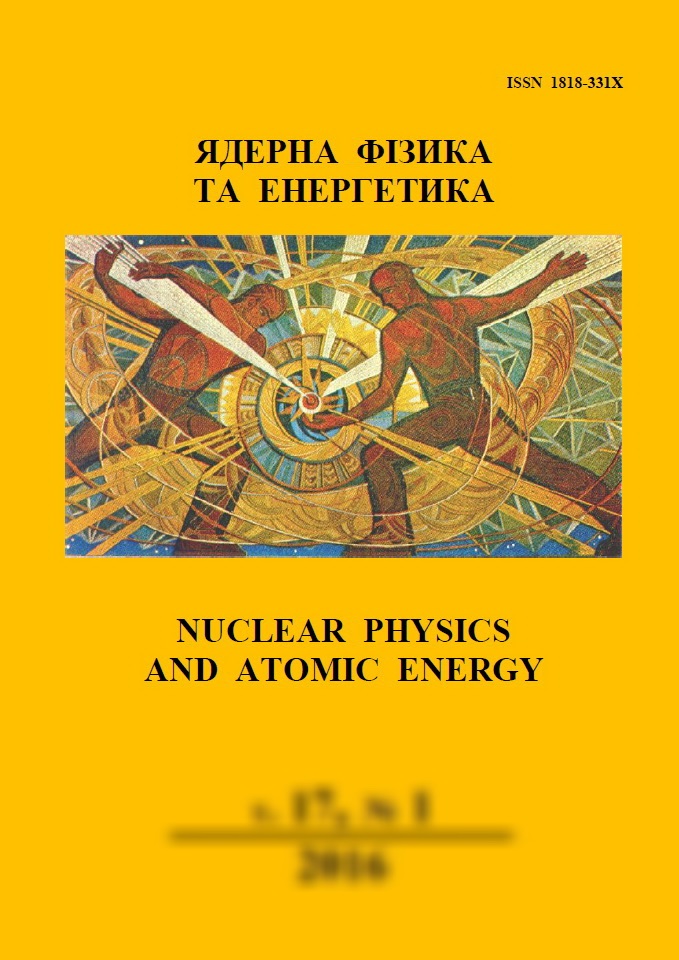 |
ядерна ф≥зика та енергетика
Nuclear Physics and Atomic Energy
ISSN:
1818-331X (Print), 2074-0565 (Online)
Publisher:
Institute for Nuclear Research of the National Academy of Sciences of Ukraine
Languages:
Ukrainian, English
Periodicity:
4 times per year
Open access peer reviewed journal
|
Nucl. Phys. At. Energy 2010, volume 11, issue 3, pages 312-319.
Section: Engineering and Methods of Experiment.
Received: 12.05.2010; Published online: 30.09.2010.
 Full text (en)
Full text (en)
https://doi.org/10.15407/jnpae2010.03.312
Pyrolytic graphite as an efficient second-order neutron filter at tuned positions of boundary crossing
M. Adib, A. Abdel Kawy, N. Habib, M. El Mesiry
Reactor Physics Department, Nuclear Research Center, Egyptian Atomic Energy Authority, Cairo, Egypt
Abstract:
An investigation of pyrolytic graphite (PG) crystal as an efficient second order neutron filter at tuned boundary
crossings has been carried out. The neutron transmission through PG crystal at these tuned crossing points as a function
of first- and second-order wavelengths were calculated in terms of PG mosaic spread and thickness. The filtering
features of PG crystals at these tuned boundary crossings were deduced. It was shown that a large number of
tuned positions at double and triple boundary crossings of the curves (hkl) are very promising as tuned filter positions.
However, only fourteen of them are found to be most promising ones. These tuned positions are found to be within the
neutron wavelengths from 0.133 up to 0.4050 nm. A computer package GRAPHITE has been used in order to provide
the required calculations in the whole neutron wavelength range in terms of PG mosaic spread and its orientation with
respect to incident neutron beam direction. It was shown that 0.5 cm thick PG crystal with angular mosaic spread of 2o
is sufficient to remove 2nd-order neutrons at the wavelengths corresponding to the positions of the intersection
boundaries curves (hkl).
Keywords:
pyrolytic graphite, neutron filter, 2nd-order neutrons, mosaic spread.
References:
1. Kostorz G. Treatise on Material Science and Technology. Vol. 15 (France, Grenoble: Academic
Press, 1979) 462 p.
2. Loopstra B. O. Neutron powder diffractometry using a wavelength of 2.6 A. Nucl. Instrum. & Methods 44 (1966) 181.
https://doi.org/10.1016/0029-554X(66)90149-2
3. Shapiro S. M., Chesser N. J. Characteristics of pyrolytic graphite as an analyzer and higher order
filter in neutron scattering experiments. Nucl.
Instrum. & Methods 101 (1972) 183.
https://doi.org/10.1016/0029-554X(72)90188-7
4. Adib M., Habib N., Fathalla M. Neutron transmission through pyrolytic graphite crystals. Annals of
Nuclear Energy 33 (2006) 627.
https://doi.org/10.1016/j.anucene.2006.01.006
5. Frikkee E. Application of pyrolytic graphite as a tunable neutron filter. Nucl. Instr. & Meth. 125 (1975) 307.
https://doi.org/10.1016/0029-554X(75)90284-0
6. Mildner D. F. R., Arif M., Werner S. A. J. Neutron transmission through pyrolytic graphite monochromators. Applied Crystallography 34 (2001) 255.
https://doi.org/10.1107/S0021889801002254
7. Adib M., Habib N., Fathalla M. Pyrolytic graphite as a selective neutron filter. Nuclear Physics and Atomic Energy 7 (2006) 135.
https://jnpae.kinr.kyiv.ua/18(2)/Articles_PDF/jnpae-2006-2(18)-0135-Adib_fin.pdf
8. Adib M., El-Mesiry M. S. Application of crystallin
graphite as a selective thermal neutron filter. Proc. of
the 2nd Int. Conf. "Current Problems in Nuclear Physics and Atomic Energy", Ukraine, Kyiv, 9 - 15 June 2008 (Kyiv, 2009) p. 516.
9. Freund A. K. Cross-sections of materials used as neutron monochromators and filters. Nucl. Inst. & Meth. in Phys. Research 213 (1983) 495.
https://doi.org/10.1016/0167-5087(83)90447-7
10. Cassels J. M. Prog. Nucl. Phys. 1 (1950) 185.
11. Naguib K., Adib M. Parasitic neutron Bragg reflections from large imperfect single crystals. Ann.
Nucl. Energy 25 (1998) 1553.
https://doi.org/10.1016/S0306-4549(98)00052-8
12. Bacon G. E. Neutron Diffraction. 3rd edition (Oxford: Clarendon Press, 1975) 636 p.
13. Adib M., Fathalla M. Computer package for graphite total cross-section calculations. Proc. 6th Nuclear and
Particle Physics Conf. Ed. by M. N. H. Comsan (Egypt, Luxor, 2007) p. 35.
14. Habib N. Polycrystalline beryllium and graphite as cold neutron filters. J. of Nuclear and Radiation
Physics 1 (2006) 137.
15. Gould C. R., Hawari A. I., Sharapov E. I. Re-Analysis of Recent Neutron Diffusion and Transmission Measurements in Nuclear Graphite. Nuclear Science
and Engineering 165 (2010) 200.
https://doi.org/10.13182/NSE09-48
